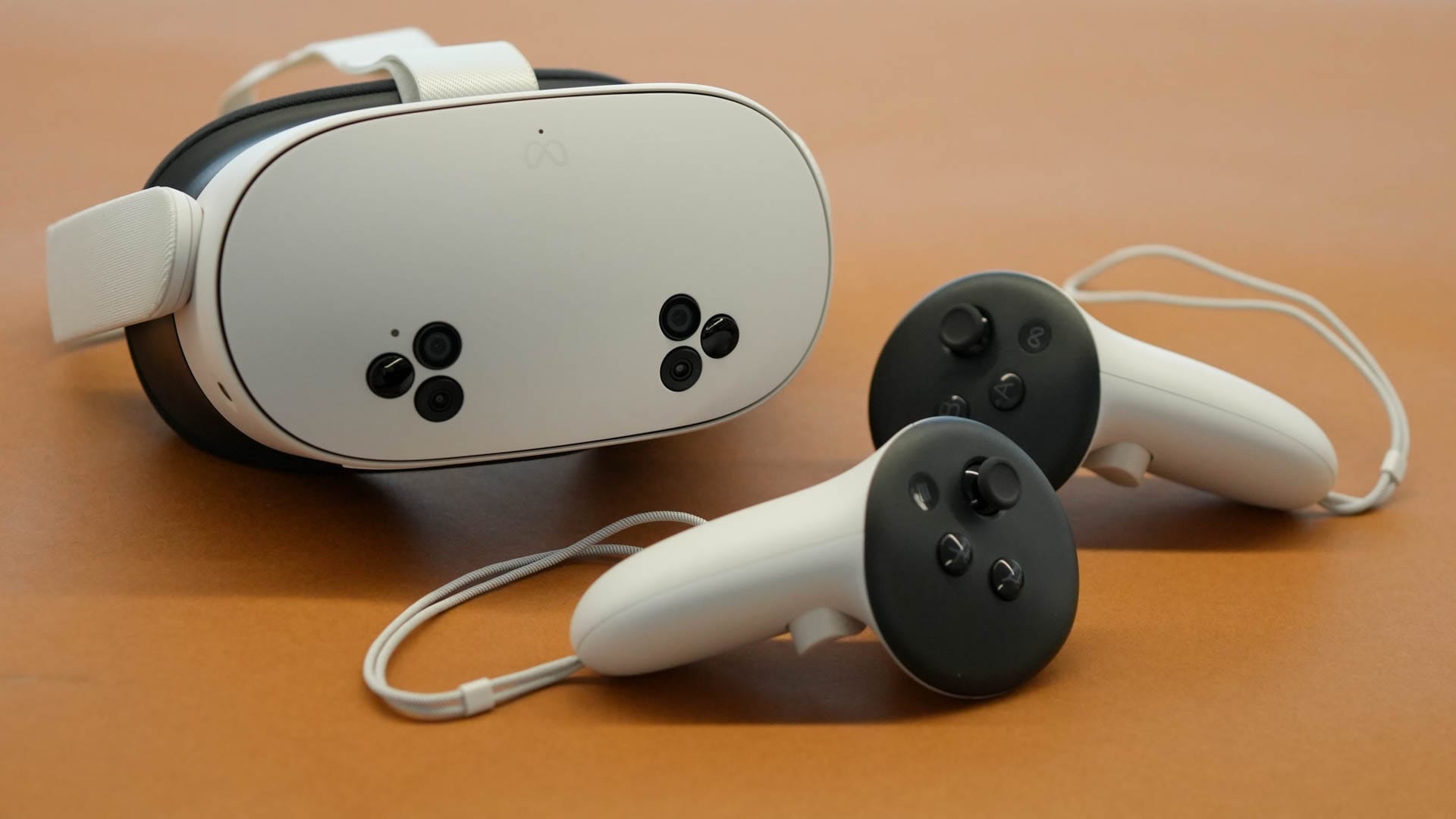After six weeks of intensive testing, I can confidently say the Meta Quest 3S has redefined what we should expect from budget VR headsets. At $299, this mixed reality powerhouse delivers an experience that rivals headsets costing twice as much, though it’s not without its compromises.
What Makes the Meta Quest 3S Special?
The Meta Quest 3S represents Meta’s strategy to bring high-quality mixed reality to mainstream consumers. As immersive gameplay, social interaction, and AI-powered personalization become more important in 2025, this headset positions itself as the entry point for millions of new VR users.
Unlike its premium sibling, the Quest 3S makes strategic sacrifices to hit that crucial sub-$300 price point while retaining the core mixed reality features that make modern VR compelling.
Key Specifications at a Glance:
- Display: Dual 1832 x 1920 per eye LCD panels (90Hz/120Hz)
- Processor: Snapdragon XR2 Gen 2
- Storage Options: 128GB ($299) / 256GB ($399)
- RAM: 8GB
- Battery Life: 2.5-3 hours typical usage
- Weight: 515g (slightly lighter than Quest 3)
- Tracking: Inside-out 6DOF with hand tracking
- Mixed Reality: Full-color passthrough cameras
Design and Comfort: Familiar Yet Refined
The Quest 3S maintains the distinctive white plastic aesthetic that’s become synonymous with Meta’s VR headsets. However, the engineering team made subtle but significant improvements to weight distribution and comfort.
Comfort Assessment After Extended Use:
During marathon 4-hour gaming sessions, the Quest 3S proved more comfortable than I expected. The slightly forward-heavy balance that plagued earlier Quest models has been largely addressed through better weight distribution and an improved strap system.
The facial interface uses a softer, more breathable material that significantly reduces the dreaded “VR face” marks. After switching between the Quest 3S and my older Quest 2, the difference in comfort is immediately noticeable.
Build Quality Observations:
- Solid construction with no flex or creaking
- Improved ventilation reduces lens fogging
- Controllers feel more premium despite cost-cutting measures
- IPD adjustment smooth and precise (58mm-72mm range)
Visual Performance: Where Compromises Show
The Quest 3S uses the same LCD technology as the original Quest 3 but with a lower resolution per eye. In practical terms, this means text appears slightly softer, and fine details in games aren’t as crisp.
Real-World Visual Testing:
Reading text in productivity apps like Immersed or Horizon Workrooms requires positioning windows closer than with premium headsets. However, for gaming and entertainment content, the visual quality remains impressive for the price point.
The 90Hz refresh rate feels smooth for most content, with the optional 120Hz mode available for supported apps. Motion clarity during fast-paced games like Beat Saber or Superhot VR exceeded my expectations.
Pancake Lenses Performance: The Quest 3S retains the excellent pancake lens technology from the Quest 3, providing:
- Edge-to-edge clarity with minimal distortion
- Reduced chromatic aberration compared to fresnel lenses
- More compact form factor
- Better visual comfort for extended use
Mixed Reality: The Game-Changer Feature
Mixed reality combines the best of both AR and VR, letting players interact with digital elements while remaining grounded in their physical space, and the Quest 3S executes this vision remarkably well for its price point.
Passthrough Quality Assessment:
The full-color passthrough cameras deliver a surprisingly usable mixed reality experience. While not as crisp as the Vision Pro’s implementation, it’s perfectly adequate for:
- Setting up play boundaries safely
- Finding your drink or phone mid-session
- Playing mixed reality games that blend virtual and real elements
- Basic productivity tasks with virtual monitors
Standout Mixed Reality Experiences:
- First Encounters – Watching aliens burst through your walls never gets old
- Mixed Reality Horizon Worlds – Building and sharing in your actual living room
- Fitness apps – Boxing trainers that adapt to your room layout
- Home theater mode – Watching movies on virtual screens in your space
Gaming Performance: Snapdragon XR2 Gen 2 Delivers
The heart of the Quest 3S is Meta’s custom Snapdragon XR2 Gen 2 processor, and it’s a significant leap forward from previous generations. Loading times are noticeably faster, graphics are more detailed, and the overall gaming experience feels more polished.
Gaming Benchmarks and Real-World Performance:
Asgard’s Wrath 2: Runs at native resolution with detailed environments and smooth 90fps performance. Loading between areas takes 15-20 seconds, compared to 30-45 seconds on Quest 2.
Beat Saber: Perfect tracking accuracy at 120Hz with no dropped frames during complex expert+ songs. The improved controllers feel more responsive than previous generations.
Horizon Call of the Mountain: Showcases the visual capabilities with impressive lighting effects and draw distances that wouldn’t look out of place on PSVR2.
Controller Improvements:
The Touch Plus controllers include several quality-of-life improvements:
- More accurate haptic feedback
- Better grip ergonomics for extended play
- Improved ring design that’s less prone to damage
- TruTouch haptics that add texture to virtual interactions
Hand Tracking: Natural Interaction Revolution
One of the most impressive aspects of the Quest 3S is its advanced hand tracking capabilities. The system now recognizes subtle finger movements and gestures that make interacting with virtual interfaces feel natural.
Hand Tracking Use Cases That Actually Work:
- Navigating the home interface without controllers
- Playing simple games like Elixir or The Curious Tale of the Stolen Pets
- Productivity apps for basic interaction and selection
- Social VR for natural gesturing and expression
The technology isn’t perfect – rapid movements can cause tracking hiccups – but it’s advanced enough to be genuinely useful rather than just a novelty.
Audio Experience: Spatial Sound Excellence
Meta’s off-ear audio solution continues to impress. The directional speakers provide excellent spatial audio without completely isolating you from your environment – crucial for mixed reality applications.
Audio Quality Breakdown:
- Clarity: Crisp highs and surprisingly full mids for open-back design
- Spatial Accuracy: Precise 3D positioning in games and movies
- Volume Range: Adequate for most environments, though very noisy rooms may require headphones
- Leak Prevention: Minimal sound bleed at reasonable volume levels
For privacy or enhanced immersion, the 3.5mm headphone jack accepts any standard gaming headset.
App Ecosystem and Content Library
The Quest platform addressed earlier content gaps seen in other VR ecosystems, and by 2025, the Meta Quest Store offers an impressive library of over 1,000 native applications.
Must-Have Quest 3S Applications:
Gaming:
- Asgard’s Wrath 2 – Epic 60+ hour RPG adventure
- Beat Saber – Still the best VR rhythm game
- Superhot VR – Time-bending action perfection
- Resident Evil 4 VR – AAA horror experience
- Population: One – Battle royale built for VR
Productivity:
- Immersed – Virtual workspace with multiple monitors
- Horizon Workrooms – Collaborative meeting spaces
- Wander – Google Street View exploration
Fitness:
- Supernatural – Subscription-based full-body workouts
- FitXR – Boxing, dancing, and HIIT classes
- Thrill of the Fight – Realistic boxing simulation
Social:
- VRChat – Unlimited social experiences
- Rec Room – Mini-games and community creation
- Horizon Worlds – Meta’s social metaverse platform
Quest 3S vs Quest 3: Is the Premium Worth It?
Having extensively used both headsets, here’s when each makes sense:
Choose Quest 3S if:
- Budget is the primary concern ($299 vs $499)
- You’re new to VR and want to test the waters
- Gaming and entertainment are your main use cases
- Mixed reality features are nice-to-have, not essential
Choose Quest 3 if:
- You plan to use the headset for productivity work
- Visual fidelity is crucial for your use case
- You have the budget for the premium experience
- You want the absolute best Meta has to offer
Side-by-Side Comparison:
| Feature | Quest 3S | Quest 3 |
|---|---|---|
| Resolution per eye | 1832×1920 | 2064×2208 |
| Storage options | 128GB/256GB | 128GB/512GB |
| Price | $299/$399 | $499/$649 |
| Processor | XR2 Gen 2 | XR2 Gen 2 |
| Mixed Reality | ✓ | ✓ |
| Battery Life | 2.5-3hrs | 2-2.5hrs |
Battery Life and Charging Experience
The Quest 3S delivers respectable battery performance for its price point. During typical mixed-use sessions (gaming, media, social apps), I consistently achieved 2.5-3 hours of continuous use.
Battery Performance by Use Case:
- Intensive Gaming: 2-2.5 hours (Asgard’s Wrath 2, racing games)
- Media Consumption: 3-3.5 hours (Netflix, YouTube VR)
- Social VR: 2.5-3 hours (VRChat, Horizon Worlds)
- Productivity Apps: 3-4 hours (Immersed, web browsing)
The included charging cable is adequately long, and a full charge takes approximately 2.5 hours. For extended gaming sessions, consider investing in an external battery pack or the official Elite Strap with battery.
Setup and User Experience
Meta has streamlined the Quest 3S setup process to be genuinely user-friendly. From unboxing to playing your first game takes approximately 15 minutes, including:
- Hardware Setup: (3 minutes) – Adjusting straps and IPD
- Software Installation: (5 minutes) – System updates and account creation
- Room Setup: (3 minutes) – Guardian boundary configuration
- Controller Pairing: (2 minutes) – Automatic when you turn them on
- Tutorial: (5 minutes) – Optional but recommended first steps
Quality of Life Improvements:
- Guardian setup is faster and more accurate
- Hand tracking calibration happens automatically
- App installation and updates occur in the background
- Cloud save syncing works seamlessly across devices
Who Should Buy the Quest 3S in 2025?
After extensive testing, the Quest 3S excels for specific user profiles:
Perfect for:
- VR newcomers wanting a premium experience without premium pricing
- Casual gamers who play 1-2 hours at a time
- Fitness enthusiasts seeking engaging workout alternatives
- Social VR users who prioritize connection over visual fidelity
- Students and educators needing affordable access to VR learning tools
Consider alternatives if you:
- Primarily work in VR productivity applications
- Are a visual quality enthusiast who notices compression artifacts
- Need more than 3 hours of continuous battery life
- Want the latest and greatest regardless of price
Comparison with Premium Competition
vs. Apple Vision Pro: The Vision Pro offers superior visual fidelity and productivity features but costs 12 times more. For most users, the Quest 3S provides 80% of the functionality at 8% of the price.
vs. PSVR2: Sony’s headset delivers better gaming visuals but requires a PS5 console and lacks mixed reality features. Total cost of entry is significantly higher.
vs. HTC Vive XR Elite: The Vive offers modular design and enterprise features but at double the Quest 3S price with a smaller content library.
Long-term Value and Future-proofing
The AR/VR space is evolving rapidly, with focus on enhancing user experience through smarter, more adaptable technologies, and Meta’s track record suggests strong long-term support for the Quest 3S.
Expected Longevity:
- Hardware: 3-4 years before feeling outdated
- Software Support: Meta typically supports devices for 5+ years
- Content Library: Continuously expanding with backward compatibility
- Resale Value: Quest devices historically retain 40-60% value after 2 years
Final Verdict: 9/10 for Value
The Meta Quest 3S achieves something remarkable – it makes high-quality mixed reality accessible to mainstream consumers without feeling like a compromised experience.
Exceptional Value Proposition: At $299, this headset delivers experiences that would have cost $1000+ just two years ago. The visual compromises are noticeable if you’re coming from premium headsets, but for the target audience, they’re entirely acceptable trade-offs.
Pros:
- Outstanding price-to-performance ratio
- Comprehensive mixed reality features
- Large, growing content library
- Comfortable for extended use
- User-friendly setup and interface
- Strong developer and community support
Cons:
- Lower resolution than premium alternatives
- Battery life could be longer for intensive users
- Some text readability challenges in productivity apps
- Requires Facebook/Meta account
- Limited storage on base model
Purchasing Recommendations and Where to Buy
The Quest 3S is available through multiple channels with varying benefits:
Direct from Meta:
- Full warranty and support
- Often includes exclusive bundle deals
- 30-day return policy
- Regular promotional pricing
Major Retailers (Best Buy, Amazon, Target):
- Competitive pricing and financing options
- Faster local availability
- Extended warranty options
- Frequent sale events
Storage Recommendation: For most users, the 128GB model provides adequate space. Power users who plan to have 15+ games installed simultaneously should consider the 256GB variant.
Essential Accessories:
- Elite Strap ($59) – Dramatically improves comfort
- Carrying Case ($49) – Protection for travel and storage
- Link Cable ($79) – PC VR gaming capability
Disclosure: This review was conducted using a retail Quest 3S purchased at full price. Meta had no input on this review’s content or conclusions.
Ready to dive into VR? Share your Quest 3S experiences or questions in the comments below!



